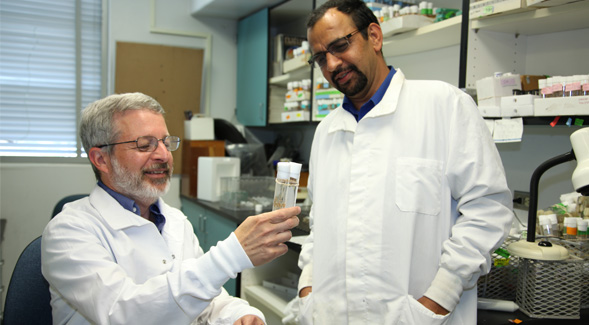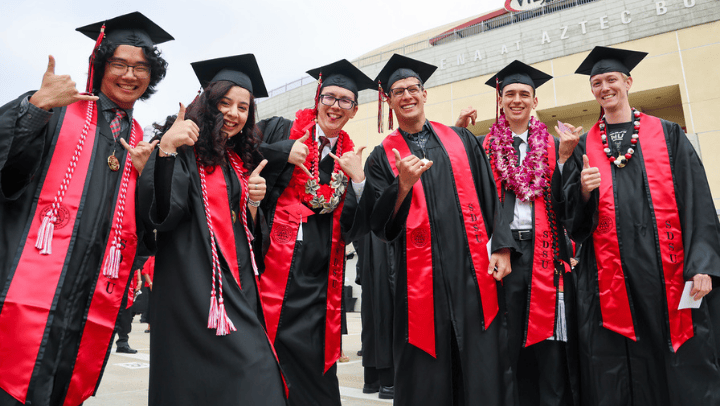The Academy Awards of Research
Four national MERIT Awards in the last decade attest to the exceptionalism of SDSU faculty.

“At SDSU, the emphasis on research and funding is very high. SDSU is punching way above its weight class.”
Updated as of 10/11/2018, 9:58 a.m.
When psychologist Phillip Holcomb received a surprise call from the National Institutes of Health (NIH) congratulating him on receiving a MERIT award, he immediately did a Google search. The grant is so rare, Holcomb had never heard of it.
He quickly learned that NIH MERIT (Method to Extend Research in Time) Awards are not only rare, but also highly prestigious grants given to researchers with well-established records of success in the lab. They allow for a broader range of investigation and a less intensive renewal process than standard NIH grants.
In the conventional world of research, MERIT Awards are unconventional. A researcher cannot apply for one. NIH chooses recipients based on their “distinctly superior” experience and productivity. Just one percent of all NIH grants are MERIT Awards, and San Diego State University has four of them—a number that’s competitive with some of the most active research universities in the nation.
“The NIH gives the award to people with proven track records and people who have contributed to their field, and SDSU has a lot of heavy hitters,” explained Holcomb, whose MERIT Award also named co-researcher Katherine Midgley. “At SDSU, the emphasis on research and funding is very high. SDSU is punching way above its weight class.”
Fundamental discoveries
Holcomb’s research looks at how the human brain processes language and the neurocognitive functions that give people the ability to read. Only in recent history has reading become a cornerstone of daily existence. The ability to read is so new, and it developed so quickly, that Holcomb and many of his colleagues don’t believe it evolved in the same way as other human abilities such as speech and fine motor skills.
Instead, he hypothesizes that the brain co-opts a different function—the ability to distinguish between objects—and combines this with the capacity to process language. Holcomb’s lab explores this further by studying how the brain’s different regions coordinate to support reading.
Jennifer Thomas is SDSU’s most recent MERIT Award winner. She studies how the essential nutrient choline, plentiful in food like eggs and liver, may improve the cognitive and behavioral function of a fetus or infant exposed to alcohol prenatally.
Her research considers how choline affects areas of the brain responsible for learning and memory and holds out the possibility of postnatal treatment for these children, many of whom have Fetal Alcohol Spectrum Disorder.
“We’ve known since the 1970s that prenatal alcohol exposure can be damaging to the fetus,” Thomas explained. “But intervention may not be possible during alcohol exposure time. What’s exciting is that we may be able to intervene after the baby is born.”
Mark Sussman and Sanford Bernstein are also SDSU’s MERIT Award recipients and distinguished professors of biology. Both have been named Albert W. Johnson University Research Lecturer, SDSU’s ultimate recognition of outstanding research and scholarship.
Sussman studies the molecular and cellular basis of heart failure. His research considers the molecular signaling pathways involved in the maintenance, aging, and regeneration of heart muscle, with the goal of developing therapeutic strategies to regenerate damaged heart tissue. Sussman’s 2008 MERIT award came at a time when research in myocardial regeneration was a relatively new concept.
“The MERIT award recognized not only our consistently high impact contributions to the field of myocardial stem cell research, but also allowed us to pursue long term detailed studies to understand the molecular regulation of stem cell activity in the damaged heart,” Sussman said.
The university's first MERIT Awards date back 30 years. Psychology professor Claire Murphy received a MERIT Award in 1990 to study the aging brain, and fellow psychologist Ed Riley received one in 1989 to research fetal alcohol exposure.
Intellectual exploration
Bernstein investigates how myosin, a protein that helps muscles contract, malfunctions in those who suffer from heart and skeletal muscle diseases.
His MERIT Award enables him to explore research questions that may not have received funding through other grant application processes. For example, he hopes to study how myosin-altering genetic treatments or drugs can improve the aging process for organisms with heart and skeletal muscle diseases.
“Given the additional time and freedom the award allows, we might be able to conduct that deeper long-term research,” Bernstein said. “It “It is more risky, but it might have a positive outcome, and that is the sort of research the MERIT Award wants to support.”
Initially, MERIT Awards include five years of funding. Researchers can apply for another five years by submitting a progress report that sidesteps the lengthy peer-review process. If the researcher can show progress toward his or her objective, the additional funding is generally awarded.
Holcomb calls this progress report a “mini-proposal” because it’s less onerous than typical renewal applications and has a good chance of approval. Under normal circumstances, the NIH awards less than 20 percent of funding applications.
John Crockett, senior director of research advancement, said MERIT Awards are structured to be highly effective funding mechanisms for researchers trying to solve complicated problems.
“The MERIT Award is long-term funding that allows recognized researchers to engage in more risky, challenging intellectual exploration that can't be done under programs requiring near-term outcomes,” he explained. “Our MERIT awardees are engaging in the process of fundamental discovery that will drive clinical interventions for the next century.”



